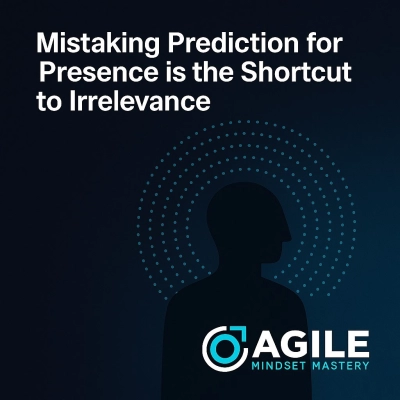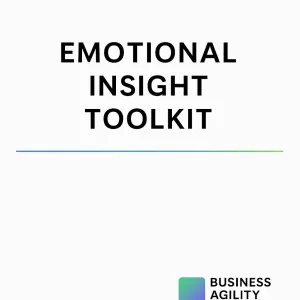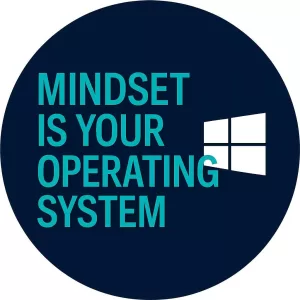Daily Lens: AI vs Human Intelligence
Both Predict - Both Forget - Both Similar - But Different AI is prediction. You are perception. But both forget and humans are better at denying it. Mindset and bias awareness aren’t soft skills. They’re system stabilisers. Keep showing up. That’s the part no machine can do for you.
Share this article:

Mistaking Prediction for Presence is the Shortcut to Irrelevance
A few years from now, someone will ask,
"When did we stop showing up?"
Not physically, we were still in the room.
But mentally. Morally.
Present.
You’ll look back at a moment, maybe it’s this week, maybe it was yesterday, when a decision was made not by leadership, not by consensus, not by gut…
But by pattern.
A prediction from a dashboard.
A probability score from an AI model.
A suggestion you accepted because, well — it was efficient.
And it wasn’t wrong.
But it wasn’t right, either.
It just… skipped the part where you would have asked:
"What matters here?"
When the Numbers Numb Us
Here’s what we get wrong about Artificial Intelligence:
It looks more like us than we’d care to admit.
Both AI and Human Intelligence are built to predict.
But we draw from different wells.
AI leans on data — wide, historical, and increasingly real-time.
Humans lean on heuristics, the shortcuts we evolved over centuries: pattern, instinct, analogy, and emotion. (Fight, Flight or Freeze)
It’s not that one is smarter. It’s that each has blind spots in different directions.
And here’s the real edge Human Intelligence holds:
Our heuristics aren’t just shortcuts, they’re stories in motion. They’re built on survival, social context, and lived ambiguity. They let us act when the data is thin, when time is short, and when nuance matters.
Heuristics allow us to take the leap, not just compute the probability.
They give us access to judgment, not just prediction. And when wielded with awareness, they help us sense the undercurrents that no dataset could ever surface.
AI doesn’t know. It just guesses better than us statistically. But it can’t feel the room shift. It won’t see the power dynamic that just snapped. It has no skin in the game, no pulse on the culture, no clue what silence really means.
It’s not missing data — it’s missing meaning.
And that’s the real gap:
AI forecasts. Humans interpret.
But interpretation takes presence. And presence takes effort.
We Both Forget — But Differently
This is the part no one puts on the keynote slide:
AI forgets unless we tell it to remember.
Humans forget and pretend we didn’t.
You've seen it. AI drops context unless engineered with memory. And even when it remembers, it has no real sense of why something matters.
But humans?
We rewrite reality to feel better.
We delete discomfort.
We smooth over uncertainty.
We convince ourselves we were never wrong.
It’s not just forgetting but distortion with confidence.
Why Mindset and Bias Training Aren't Optional Anymore
Let’s stop pretending bias training is some HR checklist. It’s not a side initiative it’s the new frontier of value delivery.
As AI implementation accelerates across industries, the real differentiator won’t be who has the best tools but who has the clearest lens.
Because when everyone has access to the same AI, the same data well, the same patterns, what determines outcomes isn’t technical power, but human clarity. So, rather than outsource our cognitive load to AI, we should be leveraging AI to develop our cognitive ability, but with clarity and human centiricity. This will be the future diffirentiator.
How do we get there?
Mindset coaching, bias detection, and reflective leadership are no longer cultural luxuries. They are operational leverage. They are the OS of AI. YOU are the OS of AI and you need to start your upgrade now.
This is exactly where systems like Agile Mindset Mastery (AMM) and the F.I.X. Framework become non-negotiable.
AMM gives you the capacity to lead without drifting.
F.I.X. gives your system a way to correct itself before it collapses under the weight of automated assumptions. Niether are replacements for oyur curent perating model. They are enhancements.
This isn’t about motivation. It’s about mission-critical awareness.
It’s not about soft skills. It’s about hard truths caught before they compound. It’s a defence system against our own drift. Because left unchallenged, humans become their own echo chambers. And AI? It just amplifies whatever signal we gave it, flaws and all.
This is where mindset work becomes infrastructure.
This is where the F.I.X. Framework earns its name.
Not a motivational loop.
A system to pull you back into the room when you’ve drifted too far into delegation to automation and echo chamber blindspots.
The Moment We Lost the Room
You can feel it happening:
We ask fewer questions.
We trust the tool too quickly.
We skip the awkward pause that might have revealed the truth. Dissent has gone and all that remains is agreeableness.
Because the system is fast.
The prediction is confident.
The output looks smart.
But no one’s asking: "Is this the right kind of smart?"
That’s the moment we stop reflecting.
That’s the moment we let the system drift.
That’s the moment we lose the room.
"The danger isn’t that AI replaces us. It’s that we stop showing up."
Try This Instead
Where have you let the smart output become the final say?
Where are you relying on pattern instead of presence?
What would it look like to step back in, even if the system says "you’re good"?
TL;DR
AI is prediction. You are perception.
But both forget — and humans are better at denying it.
Mindset and bias awareness aren’t soft skills. They’re system stabilisers.
Keep showing up. That’s the part no machine can do for you.
If this post stirred something, if you’ve felt the drift, sensed the shortcut, or want to lead with more clarity in the age of AI — let’s talk.
I’m opening my diary for 1:1 conversation slots this month for leaders and teams who are serious about mindset clarity, system redesign, and bias-aware transformation.
Send me a message or book your free, no obligatoin call. No slides. No pitch. Just presence.
This work doesn’t scale until someone chooses to step back into the room and now is your opportunity!30 minutes with John, founder of AMM
Ready to take the first step? Book your 30 minutes with John, founder of AMM and learn how you can bring presence back into the decisions that matter most.
Read more blog posts
15 Jul 2025
Daily Lens: “Good Anger” Is the New Competitive Advantage
When was the last time your team turned irritation into catalyst, not crisis?

29 Jul 2025
Mindset Is Your Operating System
Unlock leadership clarity, fix transformation bottlenecks, and overcome decision fatigue with mindset tools, emotional intelligence frameworks, and bias-aware systems—built for agile teams, waterfall programs, and high-pressure business environments.

17 Jul 2025
Why Your Team Isn’t Learning Fast Enough
(And What To Do About It)
You can deliver fast. But can you learn fast enough to keep delivering the right things?
Most teams confuse movement with momentum — speed with sense-making.
Get in touch
We want to hear from you
If you're ready to break bias, decode decisions and unlock success, we're here to help. Let's get your transformation journey started!
